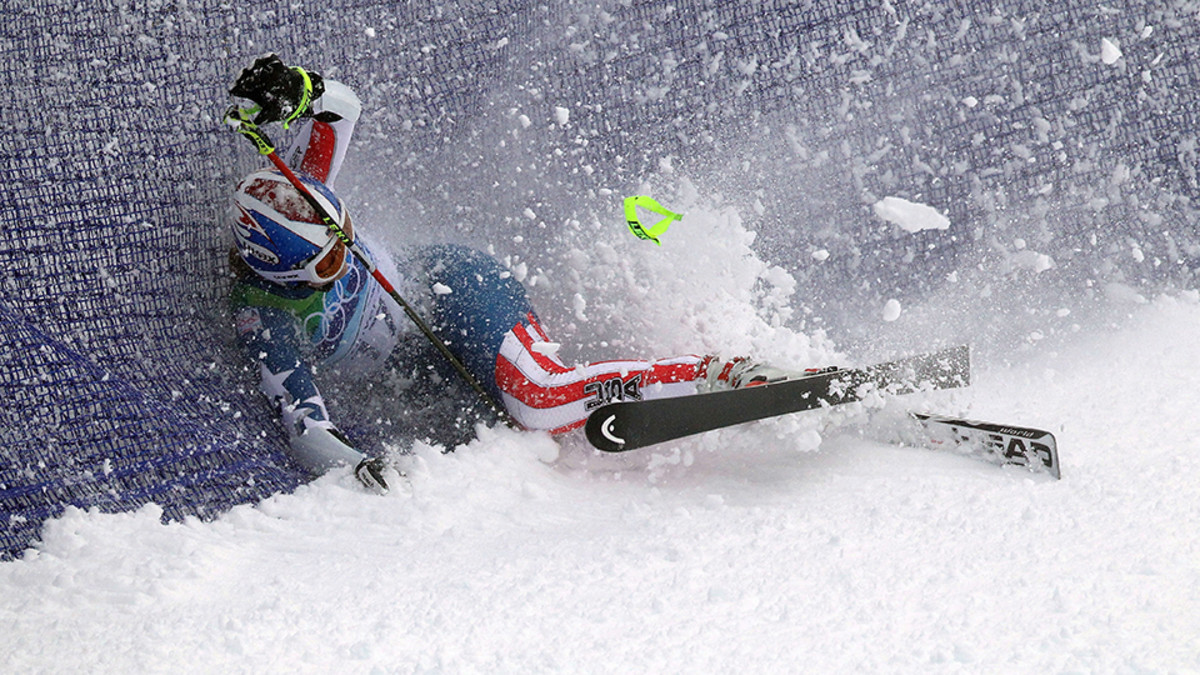Book excerpt: Exploring the dangers of World Cup ski racing
FromThe Fall Line: How American Ski Racers Conquered a Sport on the Edge,by Nathaniel Vinton. Copyright © 2015 by Nathaniel Vinton. With permission of the publisher, W. W. Norton & Company, Inc. All rights reserved.
Downhiller T.J. Lanning had hardly stopped tumbling before the pain overwhelmed him. He’d crashed going 70-plus on the Lake Louise downhill course in Canada. Hips, knees, neck -- his whole body felt broken. Sitting up, Lanning felt something wrong in his hip. Looking down, he saw the lower half of his left leg was pointing in the wrong direction, the ski still attached.
He turned to look up the hill for help, and when he did his head felt oddly balanced on his body, like he was a bobblehead doll. Panic set in, and Lanning started to scream. It was November 24, 2009, just 10 weeks before the Vancouver Games.
U.S. Ski Team head men’s coach Sasha Rearick was the first on the scene, followed shortly by Craig Faulks, a doctor traveling with the US team who had been above on the hill and skied down. They found Lanning clutching his right knee, the one he’d destroyed in a 2008 crash at Kitzbühel, Austria, even though the other one was dislocated. A medical team was soon at Lanning’s side. While they waited for a helicopter, Faulks reached out and prised open the release on Lanning’s bindings, freeing his ruined left leg from the ski that had mangled it. One of the medics had said that Lanning had broken his leg, but Faulks saw that Lanning’s knee was completely dislocated. He told the young skier to look at him and count to three, and then pulled the leg back into a normal position.
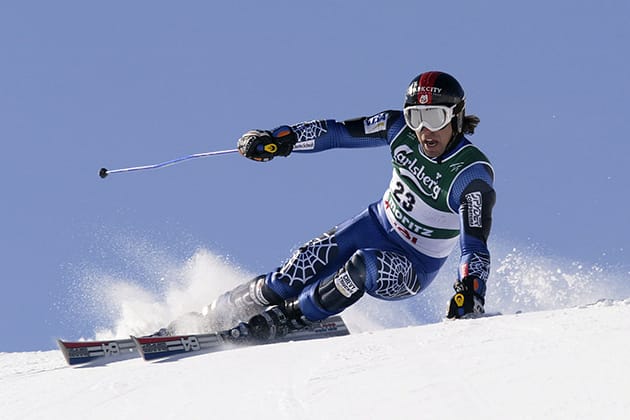
Erik Schlopy at the FIS Alpine World Ski Championships in February 12, 2003.
Alex Livesey/Getty Images
As relief rushed in, the screaming subsided, and it was Rearick who asked Lanning about his neck. Then someone reached out and stabilized it. Only later would Lanning learn that he’d fractured several bones in his neck, including cervical vertebrae C5 and C6. These were big, strong bones whose shattered fragments could have easily sliced through the soft spinal cord they were meant to protect, leaving Lanning paralyzed or dead. Despite the carnage, luck in a way had been on Lanning’s side.
At age 25, Lanning had run his last race on ski racing’s World Cup tour. Once the most promising young ski racer in the United States, he had suffered a series of brutal injuries in the six years prior to breaking his neck. Today he is a coach on the U.S. Ski Team.
*****
The key to fast skiing is the carved turn: one where the skis bend and their edges slice into the mountain to track along sharply defined channels of their own making. Carved turns leave behind curving grooves in the snow, as fine and shapely as those a figure skater etches onto an ice rink. Good racers must manage their skis in this fashion around every gate, and they must do it repeatedly, linking together an unbroken series of carved turns across changing terrain and varying snow conditions.
Push a lawnmower or a baby carriage and you can understand some of the forces at play. Turning such an object takes both hands pulling and pushing in concert. At issue is the momentum that would continue forward if not for the pilot’s execution of a combination of moves with each hand to redirect it. Ski racing is similar, except that a racer’s body is both the object being steered and the steering mechanism.
Lindsey Vonn uses her hips, knees, ankles, and (not least) her trunk muscles to redirect herself, flirting and fighting with forces that pull her in several directions. She has an instinctive feel for the fall line, the path an object would take if it were free to move on a slope under only the power of gravity.
For Vonn, the fall line is both enemy and ally. In every run she is working out an athletic compromise with gravity, alternately resisting it and surrendering to it. Making it down the mountain quickly and making it down the mountain safely are often irreconcilable goals, and few know this better than Vonn, who throughout her career has endured hideous crashes that left her with broken bones and torn ligaments.
In dozens of rag-doll tumbles, she has injured her hips, knees, hands, and brain. The smallest miscalculations have knocked her silly, bloodied her face, and sent her spinning out into the Red Room, the mordant euphemism racers use for crashes serious enough to fling them into a course’s red- orange safety netting so hard that it wraps around them as they plow to a stop. This is the cost of doing business if the business is winning ski races. If Vonn did not suppress her desire for comfort, she would have to settle for seeing other people win.
“I never think about what if I crash,” Vonn says. “While I’m skiing, I try to make the next gate. I’ll still try to not crash while I’m crashing into the net. I try to save myself until the last second. There’s no time for me to change my mind-set. I’m still fighting.”
*****
Throughout the late 1980s and 1990s, alpine ski racing evolved. It got faster, and technology was the primary accelerant. Well into the 1970s, speed suits had been made of wool, and were far more wind-resistant than the tight synthetic blends that the racers use today. Advances in ski construction conferred more stability, enhanced by plastic and metal shock-absorbing plates mounted between the ski and boot, so athletes could take a tighter line and carve more smoothly. Ski manufacturers devised machines to grind sophisticated texture into the plastic bases of the skis -- tiny grooves arranged in a geometric pattern that dispersed the snow and reduced friction. On top of the standard waxes applied to the bases, technicians could now smear on expensive powders -- fluorocarbon additives that dispelled moisture.
The snow -- injected with water, sometimes treated with chemicals -- got faster. In order to make firmer guarantees to buyers of broadcast television rights, the sport’s overseers hardened the snow, making it icier and slicker. The surface held up better during bad weather and heavy use, which had the effect of making races more fair for those going late in the start order.
A Day in the Life: Pro snowboarder Louie Vito
As average speeds on the World Cup tour rose, ski companies began manufacturing skis that harnessed natural forces as never before. The dimensions and internal construction of these new skis gave racers an unprecedented ability to carve clean turns. But the increased control came at a cost; now the smallest mistakes, the inevitable limitations of a skier’s balance, could lead to ghastly crashes.
Equipment rules were created, and endlessly adjusted, their efficacy always unclear.
Today, racers regularly travel as fast as 90 miles per hour down the same icy forest trails where their predecessors topped out at half that speed nearly a century ago. (In 2013, Johan Clarey of France exceeded 100 mph at Wengen’s Lauberhorn downhill). They hit jumps, and struggle to minimize and control their flight. In the event of a crash there are nets and airbags, and helmets and armor, but the racers’ only real protection is their brutally honed ability to maintain their footing.
When that ability retreats even for a split second, even the best racers are vulnerable to life-threatening injuries like the one that befell Norway’s Aksel Lund Svindal in 2007, when he crashed off a jump in a downhill at Beaver Creek, Colorado, site of this week’s FIS Alpine skiing world championships. After Svindal landed one of his razor sharp skis gashed his backside so badly that Svindal could have bled to death.
[pagebreak]
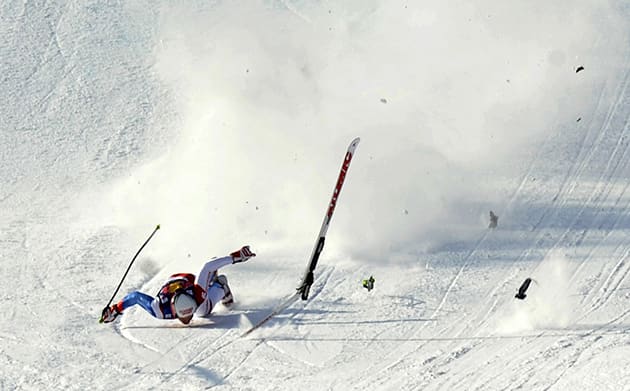
Switzerland's Daniel Albrecht crashes in front a finish area in Kitzbuhel in 2009.
SAMUEL KUBANI/AFP/Getty Images
at the top of the sport in the lead-up to Vancouver had good reason to feel extra vulnerable.
In February 2006, twenty-eight-year-old US Ski Team racer Dane Spencer crashed on a downhill course at Big Mountain, Montana, breaking his neck and pelvis. He shattered the C2 vertebra -- the second one down from the skull -- but the bone fragments spread outward, away from his spinal cord, saving him from paralysis. After a long rehabilitation, Spencer returned to racing, then became a coach.
More violence followed at Kitzbühel in 2008, a few months after Svindal’s near- exsanguination at Beaver Creek. Racing the Hahnenkamm on his thirtieth birthday, American downhiller Scott Macartney went off the Streif course’s final jump at 87 miles per hour, got twisted sideways in the air, and slammed into the snow so hard that his helmet came off. Macartney convulsed even as he slid, limp and unconscious, across the finish line. Airlifted to Innsbruck, he spent the rest of the day in a medically induced coma.
Rebecca Rusch: Mountain biking's Queen of Pain lays down the rules
Later that year, the victim was twenty-seven-year-old Austrian racer Matthias Lanzinger. The scene was Kvitfjell, Norway -- a World Cup super G. Lanzinger came over a blind jump, touched down on a collision path with a gate and slammed into it, breaking his left leg. His binding did not release, and as he cartwheeled to a stop, his still-attached ski became a powerful lever that caused his broken leg to twist violently. Two days after the accident, doctors were forced to amputate his leg below the knee.
Then, in January 2009 at Kitzbühel, Daniel Albrecht of Switzerland crashed in the same place where Macartney had been hurt, hitting the final jump going more than 85 miles per hour and tipping backward in the air as he flew an estimated 230 feet before landing on his back. His bindings and skis exploded, and his goggles shot up into the Austrian sky. The impact flung him onto his face and the lights went out -- a three-week coma. The trauma caused severe lung and brain injuries, and though he tried to return, he was never competitive again.
These catastrophes formed the backdrop for the bloodbath the 2009–10 season became in the months leading up to the Vancouver Games. In addition to T. J. Lanning breaking his neck and Nicole Hosp blowing out her knee, Canada’s world champion downhiller John Kucera broke his leg at Lake Louise, and the French team lost two racers for the season, downhiller Pierre- Emmanuel Dalcin and slalom ace Jean- Baptiste Grange.
That didn’t even count the training injuries, like Finnish racer Marcus Sandell’s accident while training on a glacier at Pitztal, Austria. Sandell flew off course into a field of boulders, losing a kidney in the process... Lara Gut of Switzerland and Peter Fill of Italy -- both leading Olympic medal prospects for their respective countries -- had suffered serious injuries in pre-season training, and in November Resi Stiegler of the United States broke two bones in her left leg in a training crash at Copper Mountain.
Even by the standards of alpine skiing, the carnage was extreme. The trend had caught the attention of reporters, their numbers bolstered by the approaching Olympics. The impact on the home team for Vancouver underlined the problem; Kucera was one of six top Canadian skiers injured before the Games. The injury rates had athletes and coaches venting their worries in the press, putting pressure on the sport’s leaders to address the issue. But what could be done? From the outset, it appeared that there were no common themes to the incidents.
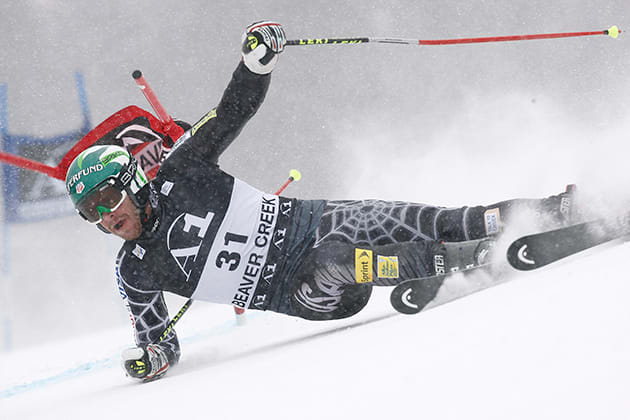
Bode Miller during the Audi FIS Alpine Ski World Cup Men's Giant Slalom on December 6, 2009 in Beaver Creek, Colorado.
Francis Bompard/Agence Zoom/Getty Images
The FIS nevertheless announced, late in December 2009, that it would form a blue- ribbon commission to review the spate of injuries, and reexamine the equipment rules once again. The sport’s purists groaned; the regulations were already getting expensive and obnoxious, with officials standing in the finish with calipers to measure boot-sole thickness, or running speed suits through a porisometer to make sure they met permeability standards.
Many skiers worried that downhill racing would regulate itself to death, for at the root of its appeal to athletes and fans alike was the concept of pure freedom to seek the fastest way from the top of the mountain to the bottom. And as with baseball, it was an old sport, and any proposed change to a rule or a venue fell under immediate suspicion. A racer tended to push the rules right up to the edge of the tolerance of those enforcing them.
*****
Throughout the late 1970s and 1980s, the FIS extended its control over the tour through its World Cup committee, and from the 1990s onward every race was overseen by a FIS race director. These officials reported to the FIS secretary general and took the lead position on the race jury, the small group that decided such things as when to cancel a race because of bad weather or sanction an athlete for misbehavior.
“That whole genre of guy is a new thing,” Miller would say, referring to the growing number of FIS officials on the tour. But their proliferation had started in the 1990s for a good reason. Of all the different factors that had intensified the FIS’s control over the way World Cup downhills were run, few were as important as a pair of tragedies that occurred in the early 1990s, when the deaths of two Austrian racers rocked the World Cup to its foundations, leading to dramatic changes in how the tour was organized.
The first came on January 18, 1991, when a twenty- year- old rookie from Pitztal named Gernot Reinstadler died after a training- run crash near the finish of the Lauberhorn downhill, when his ski caught the netting and didn’t detach. Three years later, super G world champion Ulrike Maier perished in the Garmisch-Partenkirchen downhill in Germany. Maier, in top form again after pausing her career to have a child, was tucking at 65 miles per hour when she lost control of her skis and barreled headfirst into an obstacle on the side of the course, breaking her neck.
Each of these episodes prompted searing accusations of negligence against organizers and the FIS, and in fact Maier’s case led to litigation.
Lindsey Vonn closes in on all-time World Cup wins record
In the wake of these incidents, the FIS moved to centralize its control over safety standards at World Cup races. In what amounted to a lasting monument to Reinstadler and Maier, organizers were required to install miles of intricate netting on slopes where for years only picket fencing and hay bales had held spectators back. Some of these were virtual walls of nylon, hanging from cables strung on permanent steel arms. These were the A nets, 20 feet high and more taut than any trampoline.
There were B nets too, rollable nylon fencing often placed to knock a skier off his feet before he hit the A nets.
An additional kind of barrier was produced after the December 8, 2001, crash at Val d’Isère where Silvano Beltrametti, a promising and kind- hearted twenty- two- year- old skier from Switzerland, veered off course at 70 miles per hour and sliced through a safety net, his speed seemingly undiminished, tumbling into a pile of rocks and paralyzing himself from the chest down. After that, the lower part of the netting was reinforced with plastic slip screens, making the World Cup downhill courses feel ever more walled off from course-side spectators.
In the years that followed those tragedies, the FIS and organizers have become ever more vigilant about any immovable objects placed in the race arena. Finish line installations are particularly sophisticated in their breakaway properties; occasionally, a crashing racer will slide into the posts holding up the banner above the finish line. Fans soon learn that those posts are nothing but wispy plastic, designed to explode in a scattering of broken signage and bungee cords.
The vigilance extends to the most common obstacle along the course: people. At any World Cup, those who stay within the arena during the race -- coaches, photographers, course workers -- are expected to stand in predetermined zones, with their skis off; on the rare occasion that a skier slides into those people, the standing bodies scatter like bowling pins.
[pagebreak]
*****
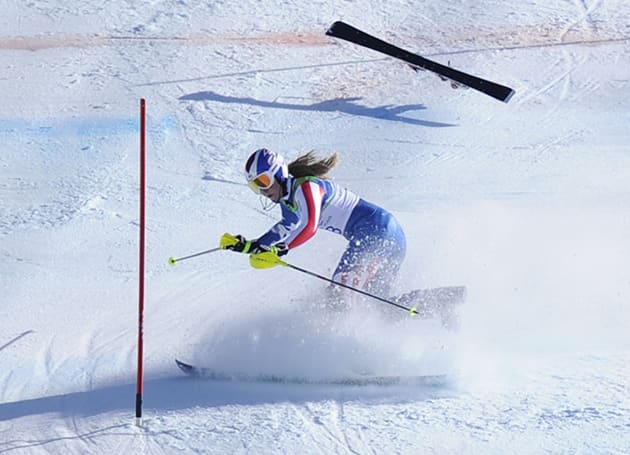
Vonn falls during the slalom of the Women's Vancouver 2010 Winter Olympics Super Combined event at Whistler Creek side Alpine skiing venue on February 18, 2010.
MICHAEL KAPPELER/AFP/Getty Images
“Each year they take away some of the teeth of these downhills,” Bode Miller says, mourning the modernization of the historic World Cup races.
It makes a lot of people in the sport uncomfortable, but that doesn’t keep Miller from bringing it up often. In the name of increased safety, turns had been added and jumps had been shaved down. When Miller started out on the tour in 1996, he believed, the courses had been true tests of skill and bravery, and the racers had risen to the challenge.
The Saslong downhill was a noted example. First built for the 1970 world championships, it had played host to nearly fifty World Cup downhill races. The start and the finish hadn’t moved, but the layout of the course had gradually evolved to contain more turns and fewer straightaways. It had always taken roughly two minutes to descend the Saslong, but modern racers were covering far more distance at a much higher rate of speed.
The consequences of the increased speed were reflected in alterations to the classic Lauberhorn course at Wengen. One of its highlights was the Haneggschuss, a long straightaway near the bottom of the course that up until the 1970s had sent racers flying off a jump called the Silberhornsprung and into a treacherous section named the Österreicherloch -- the Austrian Hole, in honor of three Austrians who crashed there in 1954.
Bobby Brown gets ready to shred the Winter X Games comeback trail
By the 1980s, racers were coming off the Haneggschuss at close to 90 miles per hour -- too fast for them to negotiate the Silberhornsprung and the treacherous terrain that followed. Organizers introduced a new right- footed turn below the Haneggschuss, designed to take racers out of the fall line and reduce their speed. Over the years, the gate marking the apex of this turn had moved out toward the fences until the racers were traveling 700 feet further than before, according to Hujara’s estimation.
As a safety measure this was an imperfect solution, chiefly because making the racers turn more promised to exacerbate their fatigue, leaving them less able to absorb terrain and make recoveries. But the main problem was that by 2009 there wasn’t much room on the tour’s classic downhills to widen the turns without cutting down trees or altering the character of the slope. The next logical step was to reduce the jumps, fill in the compressions, and make the courses smoother.
The Camel Jumps were a prime example. Over the course of Miller’s career, he had watched their profile slowly change. The distance between the two high points had shrunk -- not by much, but enough so that a racer rarely needed to spring into the air anymore to clear the gap. Fearful of the catastrophic injuries that befell racers who fell short and slammed into a wall of hard snow, organizers had begun using snowcats to reshape the humps, pushing snow onto the back side of the takeoff and the front side of the landing.
Miller was as concerned about the outbreak of catastrophic injuries as any of his peers, but the fear he voiced more often was that the FIS and local organizing committees, in response to the accidents and the looming fear of another on-snow death, were going to rob the world’s great downhills of their distinctive features.
If Miller was more vocal about these worries than his peers, it may have been because his longevity gave him a view of more evidence. He remembered the debut of Russi’s fearsome Birds of Prey downhill. In the decade since, the course had slowly been altered in places in the name of reducing speed.
No Wave is Insignificant: Surfing camp with the Paskowitz clan
By 2009, it was still a world- class downhill and one of the most difficult on the tour, but it contained much wider turns than it had when Hermann Maier conquered it in his heyday.
Miller wasn’t merely glorifying the good old days like so many sportsmen do. The changes were real. But such perspectives are always limited; Miller’s first trip to Val Gardena came in 2002, and, according to Franz Klammer, who won there a record four times, Val Gardena had by then long since been defanged.
“I think they destroyed it,” Klammer says today. “They widened the whole thing. It’s not the same Val Gardena anymore … It’s not scary.”
And so it goes, back through the decades, with every generation of downhiller telling the newest generation that the race courses have been homogenized, that the risks aren’t quite as meaningful, and that the real downhill is not available anymore. The logical conclusion is that the last downhillers passed by long ago. This theme goes all the way back to Arnold Lunn, the Englishman who organized the first Crans-Montana downhill in 1911. Lunn was a prolific writer who in his later years penned vivid histories of the sport from the hotel his family owned in Mürren, Switzerland. New-school racers, Lunn wrote in 1948, didn’t even have to hike over glaciers to earn their descent, as he had done forty years earlier.
“In those days the climb was not regarded as a tedious prelude to a downhill run,” Lunn wrote. “The austere spell of the remote and lonely snows meant as much to us as the actual run.”
Excerpted from The Fall Line: How American Ski Racers Conquered a Sport on the Edge by Nathaniel Vinton. Copyright © 2015 by Nathaniel Vinton. With permission of the publisher, W. W. Norton & Company, Inc. All rights reserved.
